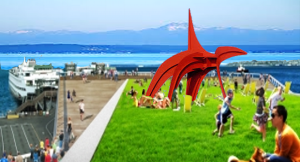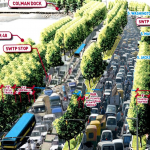Over at Crosscut, Knute Berger has a Critical Piece on the Seattle Process as Applied to the Water Front
After a meandering review of the parts of the project, he sums up saying that the budget is around $1.07 billion dollars, and likely growing as redesign occurs as we wring hands about the Department of Transportation’s warning that Big Bertha tunneling machine might not complete its job. Berger’s most worrisome meme, however, is summed up in my version of the drawings for the project (left). Is this a “Central Park” for Seattle or a state highway? When the thing is done, will there be enough private investment to fill these nine-acres with activities and events?
Berger : ” Designers have tried to hide the roadways with phalanxes of cherry trees (because) people seem more willing to pay for infrastructure….amenities — certainly captured in the design’s emphasis on play areas, amphitheaters, porch swings, sculptures, a floating pool, an ice rink, etc. — are used consistently as a major selling point.” What is not so clear is who will pay for these investments? An improvement district tax on local businesses is expected to pay part of the coats with more private sponsorships or donations covering the price for things like the floating pool barge. So don’t be surprised to see naming rights, corporate funding and private contractors being considered when it comes to running the waterfront park. Berger’s vision is scary. I have no problem with naming rights, I do have a problem if naming rights give way to Hodge Podge approach to design that suggests a focus away from the sort of key features that could bring future investment, by investments that tie this new place to the city. The proposed staircase and elevator to the Pike Place Market, as an example, is less than impressive, at least in the version shown by Mr. Corner, the expensive architect hired from New York. Equally unimpressive is the waterfront’s most central feature .. the creation of a grand promenade and bike path along the Seattle waterfront. Mr. C0rner’s biggest vision here is the use of local gravel to pave the new sidewalk.
All this brings me back to Knute’s depressing emphasis on money. Nothing in the Corner design seemed to me to be especially friendly to the small businesses that one would hope would flourish along the promenade. Making these areas attractive to businesses requires including the sort of features encourage tourists and local to do more than come down to take a ferris wheel ride or wade in Mr. Corner’s ankle deep pool. There is no theme to these amenities … Fortunately, many of the features that would attract customers are not themselves very expensive. Here are some of my own ideas:
Cheap Fixes
Make Rain a Plus:
- ample covered areas for the rain city, Hay, we LIKE the rain. These areas could sell beer too!
- rain friendly children’s playgrounds
Celebrate Bikes:
- wide bike friendly bridges with usable ramps both with sit down platforms over the six lane highway.
- a bike path that celebrates our bike culture … including public bike rentals.
Beer .. we are as much the city of 300 beers as we are the city of 300 rain days!
- beer zones .. including the platforms over the freeway
Local Themes:
- a coastal art theme .. using coastal design for pavers and walls rather than Mr. Corner’s idea that gravel aggregate fits Seattle as a gritty city. Vertical walls based on the sides of the long houses would be very inexpensive to make.
- open art areas that are tied to Seattle’s museums including moving some of appropriate art from around Seattle t
 o the waterfront … Calder’s eagle from the sculpture garden, totem poles and long house walls owned by SAM and the Burke.
o the waterfront … Calder’s eagle from the sculpture garden, totem poles and long house walls owned by SAM and the Burke. - a Trolly running from Sodo to the Sculpture Garden and Seattle Center
- expanded tie up areas for visits by picturesque boats. Again Mr. Corner seemed to not understand how boats work .. he actually showed a slide of a fully rigged square rigger, sails up, moored at the water front. A much more practical possibility is mooring for some of Seattle’s classical boats .. e.g. the Virgina V, Thea Foss, and boats from the Mosquito fleet. If at all possible, we should explore getting the US Navy or even the Coast Guard and Oceanographic Services to use waterfront tie ups.

